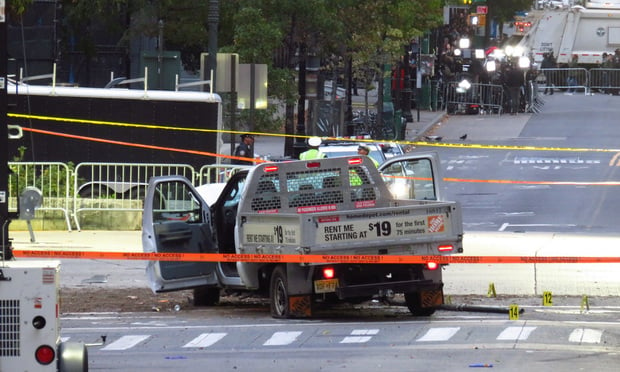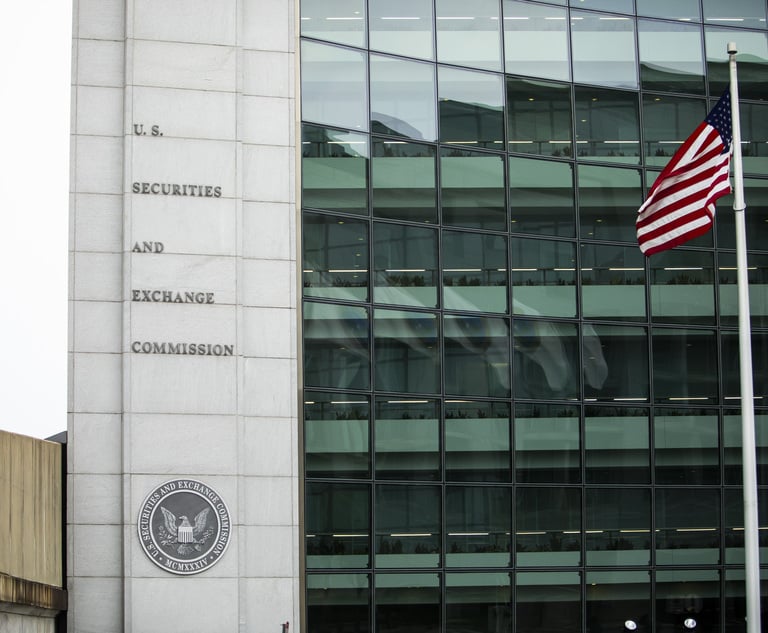Feds in Truck Attack Case Paint Saipov as Having Strong ISIS Ties
In its case against the man accused of the Oct. 31 truck attack in Lower Manhattan that left eight people dead, prosecutors are drawing strong links between the defendant and the so-called Islamic State and bringing charges against him that are more often seen in cases involving domestic criminal enterprises.
November 22, 2017 at 02:30 PM
11 minute read

In its case against the man accused of the Oct. 31 truck attack in Lower Manhattan that left eight people dead, prosecutors are drawing strong links between the defendant and the so-called Islamic State and bringing charges against him that are more often seen in cases involving domestic criminal enterprises.
Sayfullo Saipov, 29, is accused of 22 total counts, which also include attempted murder in aid of racketeering, providing material support to a designated foreign terrorist organization and violence and destruction of motor vehicles.
Twelve people were also wounded in the attack, which the government alleges that Saipov executed on Halloween because he believed more people would be on the streets.
According to court papers, Saipov, who was born in Uzbekistan, allegedly rented a flatbed truck in New Jersey and, on the afternoon of the attack, crossed over into Manhattan.
He headed downtown via the West Side Highway and, near Houston Street, allegedly veering onto a pedestrian walkway and bike lane there and began running over pedestrians and cyclists.
Saipov exited the vehicle after it crashed into a school bus and, after he emerged with what appeared to be firearms, was shot by police and arrested.
According to the criminal complaint against him, Saipov was inspired to carry out the attack—which he planned for about a year, the government alleges—by watching ISIS videos on this cellphone, which police found at the scene, and which contained ISIS propaganda, a beheading video and a video of a prisoner being run over by a tank.
The first several pages of the government's indictment against Saipov, in which the murder in aid of racketeering charge is described, are spent explaining the methods of the Islamic State of Iraq and al-Sham, referring to it as an “enterprise engaged in racketeering activity,” and alleging that Saipov sought to join the enterprise by committing the attacks.
Assistant U.S. Attorneys Andrew Beaty, Amanda Houle and Matthew Laroche are prosecuting the case. Jennifer Brown and David Patton of the Federal Defenders of New York are appearing for Saipov.
Arkady Bukh of the New York-based Bukh Law Firm said he is representing an alleged coconspirator in the alleged attack but declined to name his client.
Bukh has represented Azamat Tazhayakov, an alleged coconspirator of the Boston Marathon bombing who was indicted on charges associated with evidence tampering.
He said that a defendant facing terrorism charges may help themselves by admitting guilt early and by cooperating with the government by providing information about ISIS cells. But he said that, for Saipov, winning over a Manhattan jury may be a daunting task.
“I cannot imagine a jury will find in his favor,” Bukh said.
Christopher Tritico of the Houston-based Tritico Rainey, who was on the defense team for Timothy McVeigh, who was convicted of use of a weapon of mass destruction and other charges in the 1995 Oklahoma City bombings and executed, said the government would need to prove that Saipov has ties to ISIS to make the racketeering charges stick.
But Tritico said that, by bringing the material support and motor vehicle charges, the government is giving potential jurors a broad array of options to choose from in terms of potential counts to convict.
“The government is giving the jury a lot of opportunities,” Tritico said.
The murder aid-in-racketeering charge is more often associated with cases involving mobsters and criminal gangs, not groups thought to be associated with international terrorism.
Earlier this year, the U.S. Attorney's Office for the Southern District of New York brought murder aid-in-racketeering charges against four alleged members of the “Hot Boys” robbery crew that operated in the Washington Heights section of Manhattan.
In another example, in 2015, the leader and top enforcer for a Brooklyn gang called “Cash Money Brothers” that operated a drug-running enterprise for 13 years beginning in 1991—and which maintained control of its turf through violence—were sentenced to six life terms in prison for murder aid-in-racketeering charges and related charges.
But the murder in aid of racketeering charge has been brought in a New York terrorism case.
In 1994, El Sayyid Nosair was convicted of murder in aid of racketeering and other charges in connection with a bomb plot in New York City involving several landmarks that was intended as a follow-up to the 1993 World Trade Center bombing.
Joshua Dratel of Joshua L. Dratel PC, the first civilian lawyer to go to Guantanamo Bay to represent terrorism defendants said he found it “odd” for the government to bring murder in aid of racketeering charge outside of the context of urban gangs, as there appears to be no agreement in place between Saipov and ISIS as to how he could join up with the enterprise.
“There's no gang here,” Dratel said. “It's a racketeering enterprise that's a thousand miles away to with this particular defendant has no specific connection.”
With regard to the motor vehicle charge, which carries the death penalty or life in prison, Dratel said he knows of no successful prosecution of that statute, and questioned the government's arguments for charging him with material support.
“This concept of 'inspiration' is a far cry from the traditional material support prosecution.”

In its case against the man accused of the Oct. 31 truck attack in Lower Manhattan that left eight people dead, prosecutors are drawing strong links between the defendant and the so-called Islamic State and bringing charges against him that are more often seen in cases involving domestic criminal enterprises.
Sayfullo Saipov, 29, is accused of 22 total counts, which also include attempted murder in aid of racketeering, providing material support to a designated foreign terrorist organization and violence and destruction of motor vehicles.
Twelve people were also wounded in the attack, which the government alleges that Saipov executed on Halloween because he believed more people would be on the streets.
According to court papers, Saipov, who was born in Uzbekistan, allegedly rented a flatbed truck in New Jersey and, on the afternoon of the attack, crossed over into Manhattan.
He headed downtown via the West Side Highway and, near Houston Street, allegedly veering onto a pedestrian walkway and bike lane there and began running over pedestrians and cyclists.
Saipov exited the vehicle after it crashed into a school bus and, after he emerged with what appeared to be firearms, was shot by police and arrested.
According to the criminal complaint against him, Saipov was inspired to carry out the attack—which he planned for about a year, the government alleges—by watching ISIS videos on this cellphone, which police found at the scene, and which contained ISIS propaganda, a beheading video and a video of a prisoner being run over by a tank.
The first several pages of the government's indictment against Saipov, in which the murder in aid of racketeering charge is described, are spent explaining the methods of the Islamic State of Iraq and al-Sham, referring to it as an “enterprise engaged in racketeering activity,” and alleging that Saipov sought to join the enterprise by committing the attacks.
Assistant U.S. Attorneys Andrew Beaty, Amanda Houle and Matthew Laroche are prosecuting the case. Jennifer Brown and David Patton of the Federal Defenders of
Arkady Bukh of the New York-based Bukh Law Firm said he is representing an alleged coconspirator in the alleged attack but declined to name his client.
Bukh has represented Azamat Tazhayakov, an alleged coconspirator of the Boston Marathon bombing who was indicted on charges associated with evidence tampering.
He said that a defendant facing terrorism charges may help themselves by admitting guilt early and by cooperating with the government by providing information about ISIS cells. But he said that, for Saipov, winning over a Manhattan jury may be a daunting task.
“I cannot imagine a jury will find in his favor,” Bukh said.
Christopher Tritico of the Houston-based Tritico Rainey, who was on the defense team for Timothy McVeigh, who was convicted of use of a weapon of mass destruction and other charges in the 1995 Oklahoma City bombings and executed, said the government would need to prove that Saipov has ties to ISIS to make the racketeering charges stick.
But Tritico said that, by bringing the material support and motor vehicle charges, the government is giving potential jurors a broad array of options to choose from in terms of potential counts to convict.
“The government is giving the jury a lot of opportunities,” Tritico said.
The murder aid-in-racketeering charge is more often associated with cases involving mobsters and criminal gangs, not groups thought to be associated with international terrorism.
Earlier this year, the U.S. Attorney's Office for the Southern District of
In another example, in 2015, the leader and top enforcer for a Brooklyn gang called “Cash Money Brothers” that operated a drug-running enterprise for 13 years beginning in 1991—and which maintained control of its turf through violence—were sentenced to six life terms in prison for murder aid-in-racketeering charges and related charges.
But the murder in aid of racketeering charge has been brought in a
In 1994, El Sayyid Nosair was convicted of murder in aid of racketeering and other charges in connection with a bomb plot in
Joshua Dratel of Joshua L. Dratel PC, the first civilian lawyer to go to Guantanamo Bay to represent terrorism defendants said he found it “odd” for the government to bring murder in aid of racketeering charge outside of the context of urban gangs, as there appears to be no agreement in place between Saipov and ISIS as to how he could join up with the enterprise.
“There's no gang here,” Dratel said. “It's a racketeering enterprise that's a thousand miles away to with this particular defendant has no specific connection.”
With regard to the motor vehicle charge, which carries the death penalty or life in prison, Dratel said he knows of no successful prosecution of that statute, and questioned the government's arguments for charging him with material support.
“This concept of 'inspiration' is a far cry from the traditional material support prosecution.”
This content has been archived. It is available through our partners, LexisNexis® and Bloomberg Law.
To view this content, please continue to their sites.
Not a Lexis Subscriber?
Subscribe Now
Not a Bloomberg Law Subscriber?
Subscribe Now
NOT FOR REPRINT
© 2025 ALM Global, LLC, All Rights Reserved. Request academic re-use from www.copyright.com. All other uses, submit a request to [email protected]. For more information visit Asset & Logo Licensing.
You Might Like
View All
New York-Based Skadden Team Joins White & Case Group in Mexico City for Citigroup Demerger

Bankruptcy Judge Clears Path for Recovery in High-Profile Crypto Failure
3 minute read
US Judge Dismisses Lawsuit Brought Under NYC Gender Violence Law, Ruling Claims Barred Under State Measure
Trending Stories
Who Got The Work
J. Brugh Lower of Gibbons has entered an appearance for industrial equipment supplier Devco Corporation in a pending trademark infringement lawsuit. The suit, accusing the defendant of selling knock-off Graco products, was filed Dec. 18 in New Jersey District Court by Rivkin Radler on behalf of Graco Inc. and Graco Minnesota. The case, assigned to U.S. District Judge Zahid N. Quraishi, is 3:24-cv-11294, Graco Inc. et al v. Devco Corporation.
Who Got The Work
Rebecca Maller-Stein and Kent A. Yalowitz of Arnold & Porter Kaye Scholer have entered their appearances for Hanaco Venture Capital and its executives, Lior Prosor and David Frankel, in a pending securities lawsuit. The action, filed on Dec. 24 in New York Southern District Court by Zell, Aron & Co. on behalf of Goldeneye Advisors, accuses the defendants of negligently and fraudulently managing the plaintiff's $1 million investment. The case, assigned to U.S. District Judge Vernon S. Broderick, is 1:24-cv-09918, Goldeneye Advisors, LLC v. Hanaco Venture Capital, Ltd. et al.
Who Got The Work
Attorneys from A&O Shearman has stepped in as defense counsel for Toronto-Dominion Bank and other defendants in a pending securities class action. The suit, filed Dec. 11 in New York Southern District Court by Bleichmar Fonti & Auld, accuses the defendants of concealing the bank's 'pervasive' deficiencies in regards to its compliance with the Bank Secrecy Act and the quality of its anti-money laundering controls. The case, assigned to U.S. District Judge Arun Subramanian, is 1:24-cv-09445, Gonzalez v. The Toronto-Dominion Bank et al.
Who Got The Work
Crown Castle International, a Pennsylvania company providing shared communications infrastructure, has turned to Luke D. Wolf of Gordon Rees Scully Mansukhani to fend off a pending breach-of-contract lawsuit. The court action, filed Nov. 25 in Michigan Eastern District Court by Hooper Hathaway PC on behalf of The Town Residences LLC, accuses Crown Castle of failing to transfer approximately $30,000 in utility payments from T-Mobile in breach of a roof-top lease and assignment agreement. The case, assigned to U.S. District Judge Susan K. Declercq, is 2:24-cv-13131, The Town Residences LLC v. T-Mobile US, Inc. et al.
Who Got The Work
Wilfred P. Coronato and Daniel M. Schwartz of McCarter & English have stepped in as defense counsel to Electrolux Home Products Inc. in a pending product liability lawsuit. The court action, filed Nov. 26 in New York Eastern District Court by Poulos Lopiccolo PC and Nagel Rice LLP on behalf of David Stern, alleges that the defendant's refrigerators’ drawers and shelving repeatedly break and fall apart within months after purchase. The case, assigned to U.S. District Judge Joan M. Azrack, is 2:24-cv-08204, Stern v. Electrolux Home Products, Inc.
Featured Firms
Law Offices of Gary Martin Hays & Associates, P.C.
(470) 294-1674
Law Offices of Mark E. Salomone
(857) 444-6468
Smith & Hassler
(713) 739-1250







